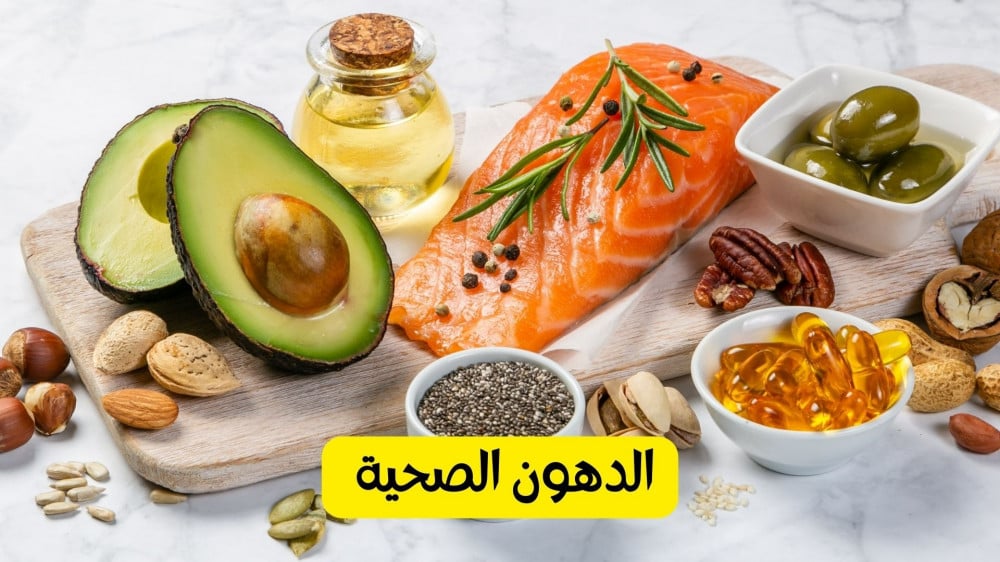Healthy fats
Fats are an important part of your diet, but some types are healthier than others. So, you need to know which types to choose and which ones to avoid.
Dietary fat is the fat that food contains. The body breaks down dietary fat into parts, called fatty acids, which can enter the bloodstream. The body can also form fatty acids from carbohydrates in food.
The body uses fatty acids to create the fats it needs. These fats consist of important elements that determine the way the body uses various vitamins. Fats also play a role in how all cells in the body are formed and how they work.
However, not all dietary fats are the same, and each has a different effect on the body. Some dietary fats are essential, some increase the risk of disease, and some help prevent disease.
Some high-fat foods, including dairy products, eggs and plants like avocados, contain important nutrients that can benefit your health. Many of them contain protein, fiber and essential vitamins.
Although dietary fat was previously avoided as a major contributor to heart disease, researchers have found that it can offer some benefits.
However, the American Heart Association recommends that saturated fats be limited to less than 10% of total calories. Although some saturated fats, such as those found in dairy products, may not have the same negative effect as the saturated fats found in red meat.
However, full-fat foods may offer more benefits than their low-fat or fat-free counterparts. They are usually less processed and contain less sugar and carbohydrates.

Types of fats:
Dietary fats are classified into two main types: saturated fats and trans fats. These two terms describe the chemical composition of fatty acids.
Most foods contain a mixture of different types of fat, but some contain higher levels of saturated fat, and others contain higher levels of trans fat. The main differences between fats include:
1- Saturated fats.
Saturated fats are usually solid at room temperature. The most common sources of saturated fat are meat and dairy products.
2- Unsaturated fats.
Trans fats are usually liquid at room temperature. Vegetable oils, nuts and fish contain mostly unsaturated fats. There are two types of unsaturated fats: monounsaturated fats and polyunsaturated fats.
Foods rich in saturated fat include:
- Foods baked or fried using saturated fats.
- Meat, including beef and lamb, as well as poultry, especially skinless poultry.
- Milk derivatives such as butter and cream.
- Whole milk or 2% fat.
- Cheese or yogurt made from whole milk.
- Oils extracted from coconuts, palm fruits or palm kernels.
Saturated fat can accumulate quickly in foods that contain multiple ingredients. According to American Diets, the most common sources of saturated fat are sandwiches, burgers, tacos, and burritos; That is, foods that usually combine meat and dairy products. Other common sources of saturated fat include buttered baked goods, full-fat ice cream, and other desserts.
Saturated fats often raise blood cholesterol levels. Low-density lipoprotein is called "bad" cholesterol. High-density lipoprotein is called the “good” cholesterol. Saturated fats cause high levels of both types.
High levels of harmful cholesterol in the bloodstream increase the risk of cardiovascular disease.
Limited scientific evidence suggests that saturated fat and high cholesterol levels may be linked to an increased risk of developing Alzheimer's disease or other dementia-causing diseases.
Monounsaturated fats in food
Monounsaturated fats are found in many foods, including meat and dairy products. Half of the fats in these foods are saturated and the other half are monounsaturated.
Many plants and vegetable oils are high in monounsaturated fat and low in saturated fat. It includes:
- Olive oil, pistachio, canola seeds, safflower seeds and sunflower seeds
- Avocado
- pumpkin seeds
- Sesame seeds
- Almonds
- Cashews
- Peanuts and peanut butter
- pecan
Monounsaturated fats from plants can lower bad cholesterol levels and raise good cholesterol levels. It can also improve control of blood sugar levels.
Using monounsaturated fats instead of saturated fats in the diet can lower the level of bad cholesterol and triglycerides in the blood. Triglycerides refer to fat cells that circulate in the bloodstream and are stored in the body's fat cells. High levels of triglycerides in the blood increase the risk of cardiovascular disease.
Eating plant foods rich in monounsaturated fats - especially cold-pressed extra-virgin olive oil and nuts - can have benefits for heart health and regulating blood sugar levels.
Polyunsaturated fats in food
Polyunsaturated fats are divided into two categories: omega-6 and omega-3 fatty acids.
Omega 6. Sources of omega-6 fatty acids include:
- corn oil.
- Cottonseed oil.
- Peanut oil.
- Soy oil.
- Sun flower oil.
The benefits of a diet rich in omega-6 fatty acids — especially when they replace saturated fats — may be related to:
- Reducing cholesterol level.
- Reducing triglyceride levels.
- Raising the level of beneficial cholesterol.
- Better control of blood sugar level.
Omega-3. Sources of omega-3 fatty acids include oily (fatty) fish, seeds, and nuts:
- Fish such as salmon, anchovies, mackerel, herring, sardines and tuna.
- Oils extracted from canola, soybeans, walnuts and flax seeds.
- soybean.
- Chia seeds.
- Flax seeds.
- Walnut.
Diets rich in omega-3 fatty acids can provide health benefits, including:
- Reducing the level of triglycerides in the blood.
- Reducing the risk of cardiovascular disease.
- Trans fats in food
1- Trans fats
It is a type of fat that leads to higher levels of harmful cholesterol and lower levels of beneficial cholesterol.
Very small amounts of trans fats are found naturally in meat, milk, and their derivatives extracted from grass-fed animals such as cows, sheep, and goats.
But most trans fats are found in vegetable oils that have been chemically treated to turn into solid fats. These products are called partially hydrogenated oils. In the past, trans fat oils were thought to be a healthy alternative to saturated fats. It was also characterized by its low price and long shelf life.
Try these tips to reduce unhealthy fats in your diet:
- Use vegetable oils instead of butter or grease. For example, you can sauté vegetables in olive oil instead of butter. Also use canola oil for hot cooking such as sautéing or stir-frying.
- Add fish to your diet, especially fatty fish.
- Choose lean meats and skinless poultry. Trim visible fat from meat. Remove fat and skin from poultry.
- Eat low-fat dairy products.
- Eat fruits and vegetables when you feel hungry.
- Reduce portions of processed foods that often contain saturated fats.
- Read the labels of processed, lean or fat-free foods, as they may contain high amounts of added sugars and added sodium (salt).
Our product: Lory peanut butter - Lory saseme tehini
References:
- https://draxe.com/nutrition/healthy-fats/
- https://www.webmd.com/diet/ss/slideshow-healthy-fat-foods
- https://www.medicalnewstoday.com/articles/322295#eggs
- https://www.healthline.com/nutrition/10-super-healthy-high-fat-foods#fatty-fish

